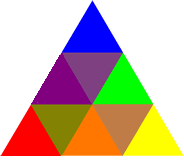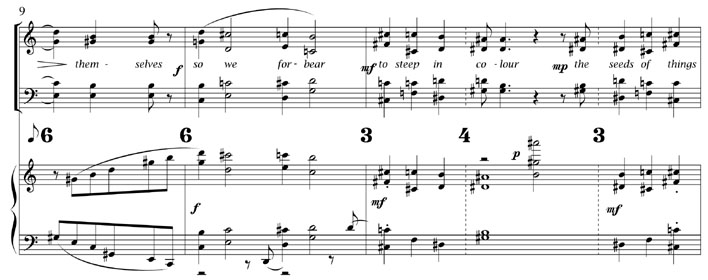For SATB choir and solo piano.

Goethe’s colour triangle.
Josef Albers was an American artist and educator who developed an experimental way of studying and teaching colour. His book
Interaction of Color (Yale University Press 1974) puts practice before theory and aims to help the artist develop a sensitivity for colour leading to an awareness of the interdependence of colour with form and shape. To achieve this Albers assembles a collection of exercises which require little but coloured paper and a pair of scissors. What Albers is doing is helping the student artist learn for him or herself about the affect of colour, its sensation; what the eye sees when particular colours and shapes come together.
Such experience can then form the basis of a personal vocabulary or practice that the artist can use within their own artistic vision. One of the devices that influenced Albers was the Colour Triangle or Pyramid devised by the poet Goethe in his Theory of Colour (1827). Albers teased out from this triangle a series of colour relationships that had particular expressive characteristics; he gave these names Lucid, Serious, Mighty, Serene, Melancholic. These titles describe particular groupings of colour that seem to contain the essence of particular emotional or psychological states. They provide a rich starting point for a musical invention linked to aspects of both colour and and communication.

The three remote ensembles performing Conversations in Colour
Five Studies after Josef Albers is written for SATB choir and solo piano lasting about 12 minutes. It has been realised from the composer’s inter-performance
Conversations in Colour commissioned by BBC Wales for a major digital arts event devised by BBC Wales called Platfform 2001. The original composition was ‘a triangular exchange of sounds, visuals’ and music devised by Nigel Morgan and digital artist Jo Hyde. Produced by Andrew Burke and Jeremy Garside of RESOUND the education and community department of the BBC National Orchestra of Wales, it was first performed during a day-long experimental webcast in April 2001 and subsequently at the ILIOS Festival, Norway in 2002. The original score sets words by Josef Albers, Bridget Riley, Lucretius and Margaret Morgan and involved the forces of a chamber choir, a percussion ensemble, and an instrumental quintet led by members of a continuo trio of MIDI instruments along with electroacoustic music and interactive sound and visual processing.

from Mighty
Five Studies after Josef Albers is a new choral version of Conversations in Colour. It was devised to coincide with the revision of the musical strands of the original work. It imagines the choral part afresh, dispensing with the use of microphones and amplification, and reworking all the spoken and whispered passages into pitched music. In doing so the rhythmical content has often been altered or expanded.
The music focuses on the notion of harmony as musical colour, specifically the interaction of one chord with another, and this in very much the same spirit as Albers’ own experiments. Proximity via duration, intensity of dynamics, the play of register, the use of inversion and transposition are all explored.
The work is intended for either four solo singers or a chamber choir of no more than 30 singers. Tempo, dynamics and articulation indicated should be considered as a guide, no more. The piano part should not be regarded as an accompaniment: it rarely provides any cues for or doubling of the choral part. Players who undertake this score are advised to study the composer’s work for solo piano The Goethe Triangle.

from Melancholic
The text of the
Five Studies is taken variously from: Albers’ haiku-like poems, an interview with artist Bridget Riley recalling her personal journey towards working with and understanding colour, and a poetic rendering by Margaret Morgan of words by Lucretius. These texts along with images by Josef Albers can be viewed in the web presentation that accompanies
Conversations in Colour.
Downloads
Study score [pdf]




